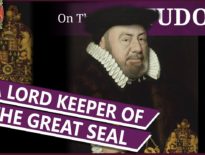On this day in history, 29th December 1605, in the reign of King James I, forty-seven-year-old Tudor nobleman George Clifford, 3rd Earl of Cumberland was buried at Holy Trinity Church, Skipton, Yorkshire. Clifford was a courtier, naval commander, privateer, Elizabeth I's champion and a man she called her "rogue".
Find out all about this Earl of Cumberland, his unhappy marriage, his voyages and what it meant to be the queen's champion, in today's talk.
You can see photos of his armour at https://www.metmuseum.org/art/collection/search/23939
Also on this day in history, 29th (or 30th) December 1605, in the reign of King James I, Elizabethan navigator and explorer, John Davis died near Bintang, off the coast of Borneo. He died after being attacked by Japanese pirates. Davis is known for his voyages, for being the first Englishman to document a sighting of the Falkland Islands, for his 1594 “The Seaman's Secrets” and 1595 “The World's Hydrographical Description", and for his invention, the Davis Quadrant, or the backstaff.
Find out more about him, his final voyage and death in last year’s video:
Also on this day in history:
- 1494 – Death of William Selling (Celling), Prior of Christ Church, Canterbury, diplomat and humanist scholar. He was buried at Canterbury Cathedral, in the martyrium of Thomas Becket.
- 1605 – Death of Arthur Hall, member of Parliament, courtier and translator. He was buried at Grantham in Lincolnshire. Hall is known for his 1581 “Ten Books of Homer's Iliades, translated out of French”, the first English translation of Homer's Iliad. Hall was imprisoned at various times on account of debt and works he published, which were either libellous or offensive. He may even have been in prison for debt at his death.
Transcript:
On this day in history, 29th December 1605, in the reign of King James I, forty-seven-year-old Tudor nobleman George Clifford, 3rd Earl of Cumberland was buried at Holy Trinity Church, Skipton, Yorkshire. Clifford was a courtier, naval commander and Elizabeth I's champion.
Let me give you a few facts about Elizabeth’s champion…
• George Clifford was born on 8th August 1558 at Brougham Castle in Westmorland, now Cumbria. He was the son of Henry Clifford, 2nd Earl of Cumberland, and his second wife, Anne Dacre, who was daughter of William Dacre, 3rd Baron Dacre.
• He spent his early life in the family estates in Westmorland and also at Skipton Castle in Yorkshire, and he was brought up a Catholic.
• Clifford’s father died in early 1570, when Clifford was just 11. He inherited the title, Earl of Cumberland, and his father’s estates and property, but was made a ward of the crown. Francis Russell, 2nd Earl of Bedford, with whom Clifford’s father had been negotiating a marriage match for his son, was granted Clifford’s wardship. The Russells were Protestants, so Clifford’s upbringing changed when he went to live with them in Hertfordshire.
• In 1571, Clifford started at Trinity College, Cambridge, where he was taught by John Whitgift, a man who would become Archbishop of Canterbury. He graduated with a Masters in 1576.
• In June 1577, Clifford married the Earl of Bedford’s daughter, Margaret Russell, in a ceremony attended by Queen Elizabeth I at the church of St Saviour, Southwark. The couple went on to have three children: Anne, Francis and George, but their sons died young.
• Margaret described their marriage as 'a dance to the pilgrimage of grief' and complained of Clifford’s spendthrift nature. Clifford took mistresses and had at least two illegitimate children, and the couple separated in the 1590s.
• In 1586, Clifford sat on the commission which tried Mary, Queen of Scots, for treason, and in that same year he financed a privateering venture to plunder the South Seas. However, the venture was a failure.
• In 1587, Clifford left England to sail for Sluys to help protect it from the Duke of Parma. It fell before he arrived, but he did play a part defending England against the Spanish Armada in 1588. He provided two ships and served on his ship the Elizabeth Bonaventure. He played an active role in the Battle of Gravelines.
• In 1588, he set off privateering, borrowing two ships from the queen for the expedition, but the expedition wasn’t particularly successful. However, he had more luck with his 1589 expedition to the Azores, taking lots of spoils back to England.
• Elizabeth I nicknamed Clifford her “rogue” and in 1590, following the retirement of Sir Henry Lee, she made him her champion, a position which he held until Elizabeth died in March 1603. As champion, Clifford performed at jousts, particularly the Accession Day ones on 17th November every year, where he would also give a speech. The portrait you see with this video shows Clifford dressed as champion ready to joust.
• In 1592, Clifford was elected to the Order of the Garter.
• In the 1590s, Clifford carried out further privateering ventures, one of which led to an argument with the queen when she claimed most of what was left after the spoils were plundered by the sailors. He was able to recover £36,000 though!
• In 1593, a voyage to the Azores was cut short when Clifford was taken ill. He was saved from death by dehydration when his captain was able to get a cow for milk for him. Anotehr voyage to the Azores in 1594 was a failure, but this didn’t prevent him from spending £6000 on a new ship, the Malice Scourge and sending her on a voyage, which he didn’t accompany, in 1595, which didn’t do much. Two planned voyages for 1596 and 97 were both cut short.
• In 1598, Clifford undertook his final voyage, sailing to Puerto Rico, backed by London merchants. Out of the twenty ship fleet, Clifford owned six, and he took with him 1000 sailors and 700 soldiers. They were able to take the town of San Juan de Puerto Rico, with Clifford nearly drowning when he fell into a moat in full armour. However, they weren’t able to hold the town as Clifford’s men came down with dysentery. They headed back home.
• In 1601, Clifford was one of the founding members of the East India Company, but he spent his final years struggling to get out of debt.
• Also in 1601 he served on the commission that tried Robert Devereux, Earl of Essex, a man he’d been good friends with.
• In 1603, following the queen’s death, Clifford was one of those who rode north to meet the new king, and James I appointed him to his privy council. He was also made warden of the west and middle Marches.
• George Clifford, 3rd Earl of Cumberland, died of the bloody flux, that is to say dysentery, on 29th October 1605 at the duchy of Lancaster house, the Savoy, in London. His sons had died young, so his heir was his brother, Francis, who became earl. Clifford’s daughter, Anne, was made Baroness de Clifford in her own right.
• Clifford was buried on this day in 1605 at Holy Trinity Church in Skipton, in the Clifford family vault.
• Clifford’s tournament armour still survives and can be found at the Metropolitan Museum of Art in New York. I’ll give you a link to see photos of it. It’s beautiful. It is decorated with Elizabeth I’s cipher, 2 Es back to back, and fleur de lis.



I have been to Broughham Castle while studying on a course on Lady Anne Clifford and to Skipton a couple of times. I went once to the Christmas Market and once or twice on a Summer visit.
The portrait of George Clifford in his armour is huge and really magnificent. Anne and Margaret were grand characters.
The Clifford Tombs include Eleanor Clifford and her young son as well as her children and grand children and her husband Henry Clifford. The claim to the throne of course came from Eleanor as the daughter of Mary, Duchess of Suffolk and her brother Henry Viii.
Margaret married Lord Stanley and was a troublesome woman.
I love the portrait of George in his Champions armour with his lance and think he looks like a dandy and the Lord Flasheart in Blackadder.